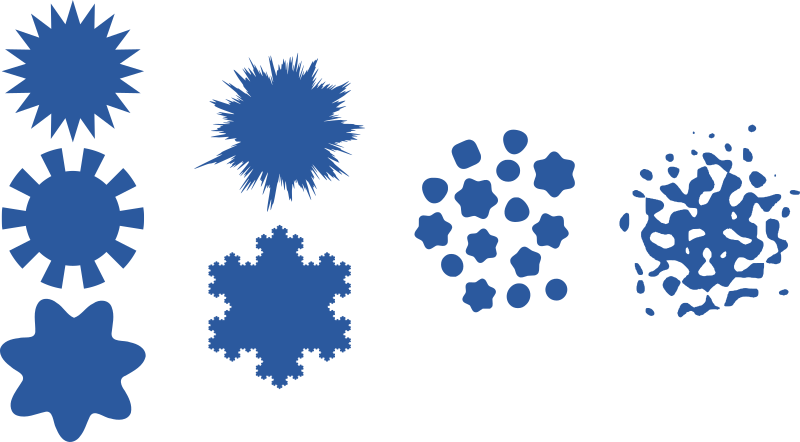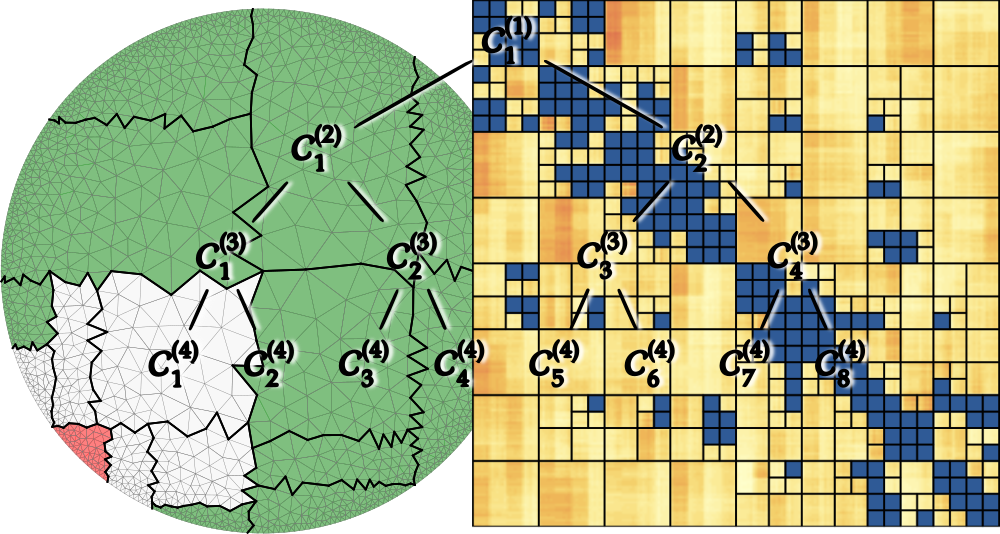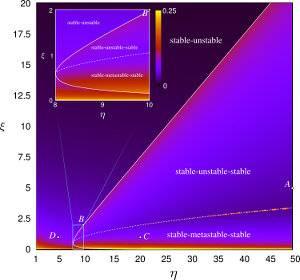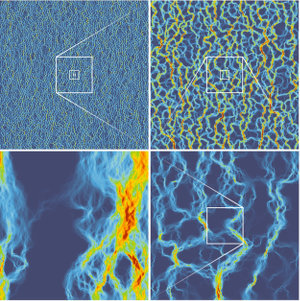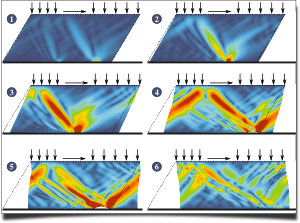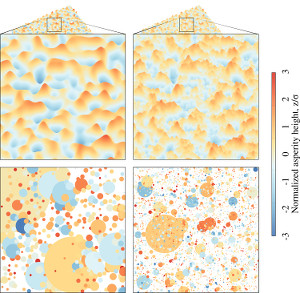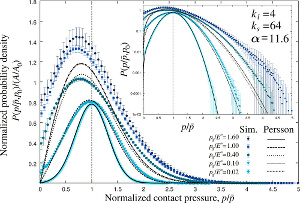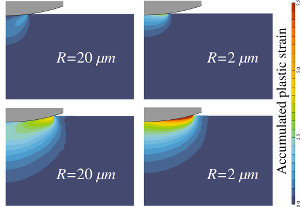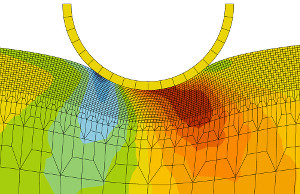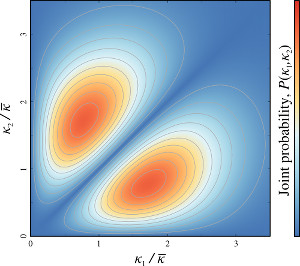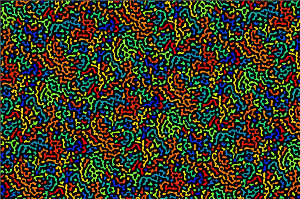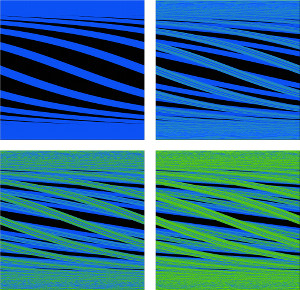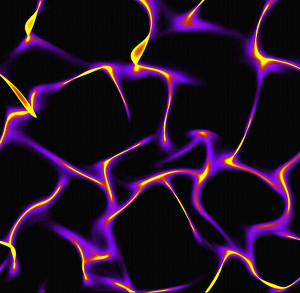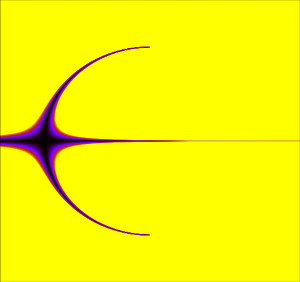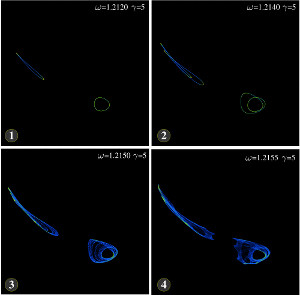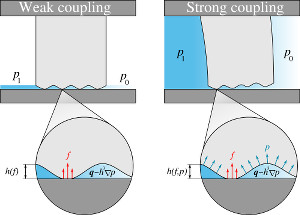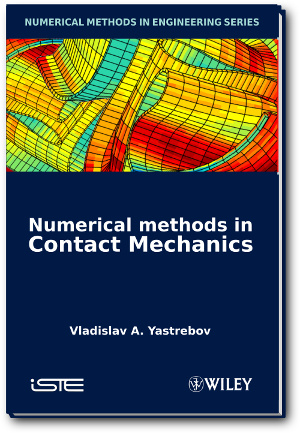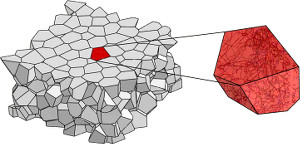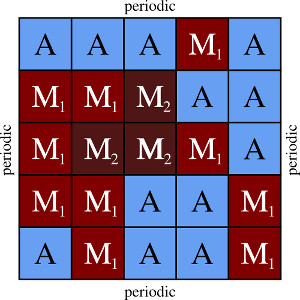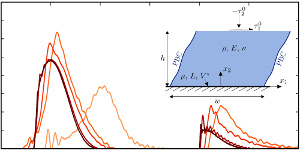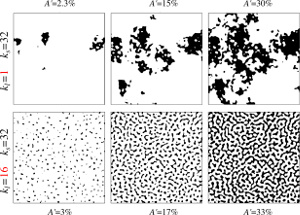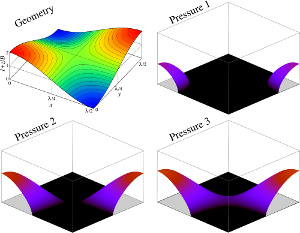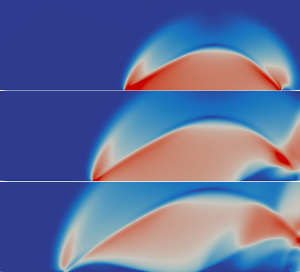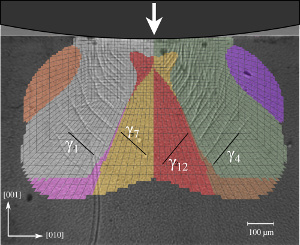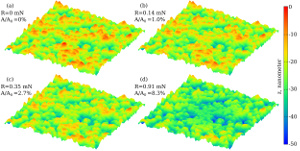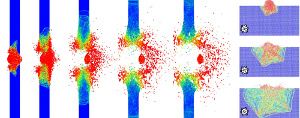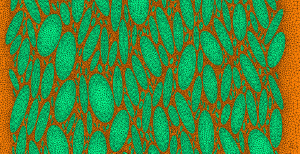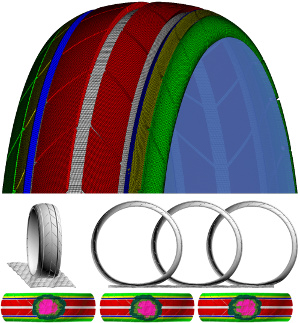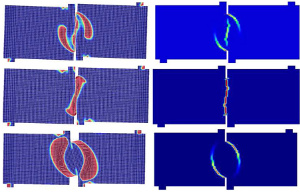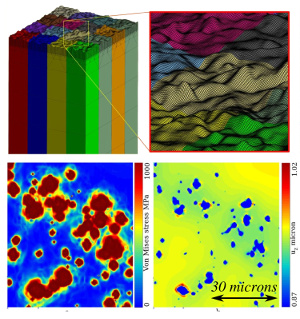Research
Main research topics and keywords
Main topics:
- Mechanics and physics of contact and friction
- Numerical methods in contact mechanics and multi-physical coupling
- Surface roughness and involved phenomena
- Mechanics of materials
Keywords:
- Contact of rough surfaces
- Elastodynamic friction
- Friction laws
- Fast-BEM and H-matrices
- Conductivity problem
- Constitutive behavior of elastomers
- Continuum damage mechanics of quasi-brittle materials
- Fluid-solid coupling at contact interface
- Electric contact
- Hard metals
- Thermo-mechanical coupling in contact
- Glacial earthquakes
- Textile-embedded microelectronics
- Non-linear dynamics of asymmetric systems
- Indentation scale effect
- Mortar method for contact
- Finite element method
- Boundary element method
- Crystal plasticity
- Homogenisation
- Discrete Dislocation Dynamics
Software and code development
- Numerical methods for contact and friction (in Z-set)
- Numerical methods for coupling Reynolds equation with contact mechanical problem (in Z-set)
- Numerical methods for fluid-solid interaction with inertial drag and depth-dependent pressure (in Z-set)
- Fast Boundary Element Method: Python repository at
, C++ repository at
- SEM/BSE 3D Surface Reconstruction: Python repository at
- Geometrical Adaptive Cross Approximation: Python repository at
- Electrostatic-Based Mesher: from image to Delaunay mesh: Python repository at
- Efficient finite difference solver for Reynolds equation: Python repository at
- Generation and analysis of rough surfaces:
C++ and Python implementations at
- SAFIM: Semi-Analytical Floating Iceberg Model: Python repository at Zenodo
- Finite Difference Solver for waves in elastically asymmetric materials: C++ repository at Zenodo
- Spectral based boundary element methods
- Molecular Dynamics code (LJ, Kastner, EAM)
- Simulator of asymmetric Lorentz gas model [to be shared]
- 2D Discrete Dislocation Dynamics code (in process of development) [to be shared]
- Electric contact simulator for random spot distribution [to be shared]
- FE meshes of bi-phase composites: spherical, elliptic, and polygonal [to be shared]
- Add-on for voro++ for generation of FE meshes of polycrystals [to be shared]
- Asperity-based rough surface model with long-range elastic interactions [to be shared]
Ongoing research projects
Projects are classified as follows:(MATH) mathematics, (NUM) development of numerical methods, (MECH) mechanics, (MULT-PHYS) multiphysics,
(GEO) geophysics, (ENG) engineering applications.
Ongoing projects involving students and postdocs
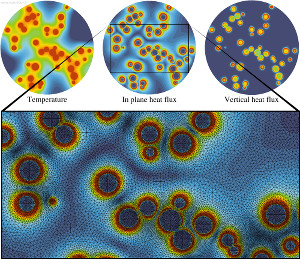
Transfer of the electric charge through a model contact surface |
Multi-material and multi-scale electric contact for weak currents: experiments and simulations (MULT-PHYS) with Frederick Sorel Mballa Mballa (postdoc), Georges Cailletaud (MINES), Henry Proudhon (MINES), Sophie Noël (LGEP), Frédéric Houzé (LGEP) An experimental and numerical study of electric contact for low currents in sphere-plane set-up is presented. A three-level multi-scale model is proposed. We use the finite element analysis for macroscopic mechanical and electric simulations. It takes into account the setup geometry, elastoplastic mechanical behavior of contacting components in the finite-strain-plasticity framework and electrostatic properties. A sensitivity analysis with respect to the brass plastic behavior and to the thickness of coating layers is also performed. The finite element results are used for an asperity-based model, which includes elasto-plastic deformation of asperities and their mutual elastic interactions. This model enables us to simulate the real morphology of contact spots at the roughness scale using the experimentally measured surface topography. Finally, the Greenwood multi-spot model is used to estimate the electric contact resistance. This three-level model yields results which are in good agreement with experimental measurements carried out in this study. |
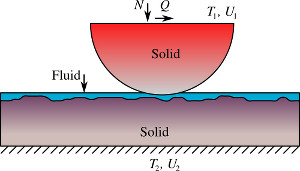
Thermo-mechanical coupling in lubricated contact |
Thermo-mechanical coupling in contact and friction problems involving incompressible fluids (MULT-PHYS) with Andrei Shvarts (PhD student), Georges Cailletaud (MINES) Multi-scale and multi-physical coupling of the contact interaction is a relatively unexplored topic in the domain of computational mechanics (physics) because of the geometrical complexity of contacting surfaces and the strong coupling involved phenomena. In this project we plan to use advanced numerical simulations within the homogenisation paradigm ``from-down-to-top''. Taking into account the essential physics and roughness of contacting solids at small scales will enable us to construct new advanced model at macroscopic scale, which will be implemented in our finite element software Z-set. This enhancement in terms of multi-functionality and polyvalency will allow us to interact with the industry on new challenging problems, which cannot be treated in the actual state of our expertise and software capabilities. Surface roughness at small scales determines the macroscopic properties of the contact interaction such as energy transfer across the contact interface or fluid transport along it. Moreover, this roughness play a crucial role in frictional, adhesion and wear mechanisms. However, the solution of a mechanical problem (even with explicitly modeled roughness) is not sufficient to understand and analyse coupled multi-physical problems, which are often encountered in industrial applications and natural phenomena. The fluid flow, for example, is described by the Navier-Stokes equation, whereas the heat production and diffusion is described by the non-stationary heat equation. At the same time, the emerging boundary value problems for these phenomena (geometry and boundary conditions) strongly depend on the the mechanical problem, whose solution in turn is influenced by the hydrostatic and hydrodynamic pressures of the fluid flow as well as by the thermal fields. First, it is planned to implement in Z-set software the thermomechanical coupling for contact problems, which would enable us to simulate the heat production due to the frictional dissipation at the interface as well as the heat exchange (direct and convective) between contacting parts. This coupling will be done at the roughness scale as well as at the macroscopic scale (Hertzian contact for smooth surfaces) with constitutive equation for the interface heat transfer emerging from the microscopic simulations. The former coupling will serve to refine our understanding of the physical phenomenon and to critically analyse (and if needed adapt) existing constitutive laws of the heat transfer. The latter coupling will be of importance for industrial applications; aircraft and vehicle engines, brake systems, friction within geological faults are among the most critical applications. Moreover, since the stationary heat equation in absence of the convective term describes the electrostatics (Poisson's equation), this framework can and will be used to simulation of electric contact (possible collaboration with parallel PhD topics). The second coupling, mechanics and fluid flow, will enable us to threat the problems of sealing and mixed lubrication. The former, essential for aeronautic and nuclear industries, requires the solution of the flow problem and its coupling to the mechanical contact at the roughness scale as well as it subsequent generalization for macroscopic scales of industrial devices. The latter problem is crucial for all industrial applications in which contacting components of a system are in relative motion, hence often the presence of liquid lubricant. The coupling shall be implemented for two-dimensional Reynolds equation (Couette and Hagen-Poiseuille flow). Both couplings will be implemented within a general architecture enabling to integrate the complete ultimate thermomechanical coupling with the fluid flow with marginal efforts. Moreover, the architecture of the novel contact scheme (dual mortar method), which will be used in this study and implemented in parallel by another PhD candidate, will be adapted for efficient realisation of the current project. The primary objective of this project is to refine our understanding of multi-physical and multi-scale aspects in frictional contact problems. The secondary objective is to ensure the readiness of our finite element software to new industrial challenges in the domain of computational mechanics. |
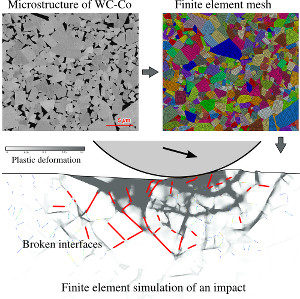
Simulation of an impact of WC-Co against a hard-rock-asperity |
Mechanical behavior and wear of hardmetals in hard rock drilling (MECH) with Dmitry Tkalich (PhD student), Georges Cailletaud (MINES), Pascal-Alexandre Kane (Sintef, Norway), Charlie C. Li (NTNU, Norway) Mechanical behavior of drilling tools made of cemented tungsten carbides is investigated in impact interaction with a hard rock. In the first step, macroscopic finite-element (FE) impact simulations with varying incident angles are carried out in order to obtain stress states evolution at critical locations within the cemented tungsten carbide impactor. Material of the impactor is modeled using a uniform field (UF) two-phase model, which is based on the Eshelby's solution of the inclusion problem, extended to elasto-plasticity by means of a b-model for plastic accommodation. Isotropic von Mises plasticity model is used for the binder phase and a non-associated Drucker-Prager model for the tungsten carbide, both models use a non-linear isotropic hardening. The validity of the UF model for cemented tungsten carbide material with its specific microstructure and material behaviors was confirmed by comparison with the FE models constructed by accurately reproducing scanning electron microscope images. In the second step, the selected stress paths are used as boundary conditions applied on three-dimensional FE models with an explicit microstructure represented by a new model based on Poisson cutting of Voronoi grains. Dispersion of stresses were studied to identify the most dangerous locations within the microstructure, which are responsible for the onset of wear and fracture of the cemented tungsten carbides. |
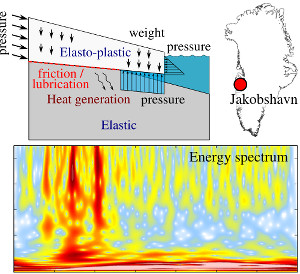
Iceberg calving/capsize in Greenland and associated energy spectrum |
Signatures of iceberg calving in seismological data (GEO+NUM) with Amandine Sergeant-Boy (PhD student), Anne Mangeney (IPGP), Olivier Castelnau (ENSAM), Jean-Pierre Montagner (IPGP), Eleonore Stutzmann (IPGP) Glacial earthquakes is a class of seismic events of magnitude up to 5, occurring primarily in Greenland, in the margins of large marine-terminated glaciers with near-grounded termini. They are caused by calving of cubic-kilometer scale unstable icebergs which penetrate the full-glacier thickness and, driven by the buoyancy forces, capsize against the calving front. These phenomena produce seismic energy including surface waves with dominant energy between 10-150 s of period whose seismogenic source is compatible with the contact force exerted on the terminus by the iceberg while it capsizes. A reverse motion and posterior rebound of the terminus have also been measured and associated with the fluctuation of this contact force. Using a finite element model of iceberg and glacier terminus coupled with simplified fluid-structure interaction model, we simulate calving and capsize of icebergs. Contact and frictional forces are measured on the terminus and compared with laboratory experiments. We also study the influence of geometric factors on the force history, amplitude and duration at the laboratory and field scales. We show first insights into the force and the generated seismic waves exploring different scenarios for iceberg capsizing. |
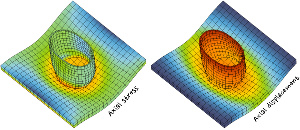
Gluing a thin-walled tube with a plate along mesh-incompatible interface using mortar method |
Development of advanced numerical methods in contact mechanics for aerospace applications (NUM) with Basava Raju Akula (PhD student), Georges Cailletaud (MINES) Recent developments in the finite element software Zset allows to solve efficiently most problems involving friction and contact. However, the implemented methods make use of specific contact discretizations that lack of accuracy in load transfer between contacting surfaces. In consequence (i) the contact patch test for non-conforming meshes cannot be passed, (ii) locally the contact pressures experience spurious oscillations, and (iii) elements with higher order interpolations require specific treatment. These problems are associated with under-interpolation of contact forces and non-satisfaction of LBB1 condition. To overcome these difficulties a new class of "surface-to-surface" contact discretizations will be implemented. Because of the weak fulfillment of contact constraints, this class of methods allows to avoid the aforementioned drawbacks and to treat contact problems with higher accuracy and improved robustness. The objective of this project is to improve numerical algorithms and resolution techniques to treat frictional contact problems in the framework of (1) parallel computing, (2) large deformation/large sliding friction contact and (3) highly non-linear materials. All developments will be carried out in the finite element software Zset and employed to solve problems from aeronautic industry including millions degrees of freedom. The ultimate aim is to deliver a robust, multipurpose and accurate contact algorithm capable to treat efficiently contact problems. |
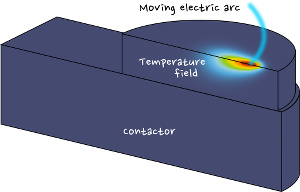
Finite element simulation of a moving-electric-arc effect |
Reliability of AgSnO2 contactor systems operating in strong currents (electric arcs) (ENG) with Fadoua Majid (master student), Georges Cailletaud (MINES), Vladimir Esin (MINES), Frédéric Houzé (LGEP), Philippe Testé (LGEP), Alexandre Bonhomme (Schneider) In this project we study microstructural evolution of the AgSnO2 contactors in operation under multiple opening/closure actions resulting in emergence of electric arcs causing damage/welding/failure of contactors. This study includes mutliple numerical experiments, microscopical observations of the microstructure evolution and coupled thermomechanical finite element simulations on effective thermo-mechanical behavior of the composite. |
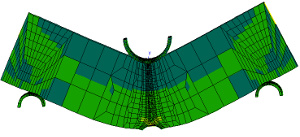
3D finite element simulation of DWTT |
Simulation of inverse fracture in Drop Weight Tear Test (DWTT)(ENG) with Takahiro Sakimoto (PhD student), Jacques Besson (MINES), Yazid Madi (MINES) In high toughness line-pipe material, inverse fracture is sometimes observed on fracture surface of Drop Weight Tear Test (DWTT) specimen. Inverse fracture is defied as the cleavage fracture that is observed after slant ductile fracture. The initiation point of inverse fracture is mostly located in the front of delamination on slant ductile fracture surface. However, the initation mechanism of inverse fracture has not yet been clarified in details. This study aims at the simulation of slant ductile fracture in DWTT in a X65 line pipe steel. The proposed simulation includes a detailed description of the anisotropic plastic behavior and material hardening behavior under high speed deformation. The slant ductile fracture behavior is modeled using the computational cell technique. Damage in each cell is represented using the GTN model for ductile fracture which is fitted using results of the notched tensile bars. These calculations are post-processed to access both delamination and cleavage leading to inverse fracture. The computational results show good agreement with the measured experimental load-displacement curve for both tensile bars and DWTT specimens. The computational results are then used to derive macroscopic failure criteria for both delamination and cleavage over a wide temperature range. Using these results, the initiation mechanism of inverse fracture is discussed from the view point of the ductile to brittle transition initiated at delamination cracks. |

